During the recent World Cup Series, Anheuser Busch ran a series of TV ads during breaks in the action. Entitled, “Rise As One,” it retold the story of the 1914 Christmas Day Truce that happened in the first months of WW1. If you’re not familiar with the history, it’s a touching story of how the soldiers in both the German and British trenches established a brief peace all on their own, and ventured out into No Man’s Land on Christmas morning, to play a friendly game of football. Soccer.
One hundred years later, I was contacted by Tarras Productions and asked if I could do a few paintings to give the film a more personal, and special feeling. I was immediately excited as this is the power of painting, to touch the heart of the subject in a way that allows the viewer to complete the scene in their own way. My paintings were to capture the feeling of those moments the agency had in mind.
At our first meeting, the art director thought that they might need 4 to 6 paintings to express the events of the day. They thought that my oil paintings would be a good fit, but they were also looking at a few other artists. They hadn’t made up their minds yet, and their client, Anheuser Busch, was inclined to work with a comic artist.
During the meeting, I quickly realized that if I was to get this job, I had to sell my work right then and there. I had to push them in my direction as I really wanted the assignment. I love that time in history and I thought that my paint would give the film the weight and gravity needed to pull off the emotion of the event.
I explained how the oil paint would bring out the feel of the mud, the grime, the awful conditions of the trenches, and the depressed facial expressions of the men. I described how the colors could be muted for effect to enhance this, and how a few accent colors could grab attention in certain places.
The meeting went well. They loved my work and told me as much. I offered to help find a good comic artist match for them, if indeed the client ultimately went in the direction. It’s always good to help share the work in the field. They said they’d get back to me.
They always say that. I figured I’d lost the job.
That was New York, and I was due to fly back to Oregon the next day. Once back in my studio, I scratched up a page of thumbnails to show them what I was thinking, based on our conversation and some notes they’d sent. A few days later, I got an email from the AD/director who asked if I could possibly do a sketch that looked like a comics page. I knew what they were going for. If they wanted to use me, I was going to have to show that I could handle storytelling in a panel-to-panel approach.
One hour later, I’d sketched the page and sent it off. Twenty minutes after, I got a call. They loved it, but…..”could you add a little color?”
“I’ll get back to you.”
Two hours later, I’d sent them a full color rendering of the page. (I’d developed a speedy way to do this: print out the page on copy paper and paint right on it. It dries really fast, and be can scanned immediately.) They were elated.
That’s what sold them and they showed it to Anheuser Busch. The job was mine.
All we had to do now was figure out the timing and payment, etc. But they had something bigger in mind. They’d decided that they needed more paintings. Thirty of them, in fact. Yikes. So I asked when they needed them.
“Two weeks.”
“But…that’s three paintings a day. With research, sketches, and sketch approval, that’s not gonna happen. I’m pretty fast, but no one’s that fast. Not in oil paint.”
“We’ll get back to you.”
They must be insane, I thought. That’s it, the job’s gone. But they called back the next day. They had a better deal. They only needed twenty-four paintings. They took away six, yet, they still only had two weeks.
“That’s two paintings a day.” But it didn’t matter, the deadline was set. I wasn’t sure how I’d do it, but I figured I just might make it, if they allowed me to send thumbnails and they’d ok each painting based on those. They were happy to hear that, and agreed. Then they mentioned the gallery shoot.
“Gallery shoot?”
They planned to put the paintings in a gallery and shoot them at a ‘faux opening,’ with patrons wandering about, looking at them.
“Wait, wait–how big do you think these are gonna to be?”
They thought they were going to be gallery-sized scale, perhaps three feet across for each. I politely informed them it wasn’t possible to cover that much canvas in the time alloted. But thinking on my feet, to keep the job, I told them that I could paint them much smaller, then have them shot by Gamma One Conversions, who could also blow them up to whatever scale they needed for the gallery setting, printed on canvas. On camera, viewers would never be able to tell if they were original or not.
They loved that one. After conference calls, technical talk, budget clearance, and much concept discussion later, I was good-to-go. Huzza!
I figured if I could find just the helmets for reference, I could freehand everything else. That proved a little difficult after calling all over the country and coming up short. I eventually found a WW1 German helmet and a doughboy helmet at a surplus store not even three miles from my studio. Figures. Should’ve called them first.
The thumbnails shown throughout the post are what I drew while looking at tons of WW1 trench reference. The art director signed off on them and I went from there. First step was to shoot reference of my model: me. I posed for every single figure in the series. I had to. There was no time to line up models.
Starting Friday, March 14th, I had to hit two paintings a day. I figured as I went along, I could adjust earlier paintings while working on the latest ones. My daily schedule was this: Up at 8 am, sketching by 9, getting ok’s by noon, shooting reference and drawing directly to canvas and getting one painting done by 6-ish. Drive to Starbucks, sit and stare over a mocha for one hour. Back to painting until midnight. Watch something until tired by 1am. Back up by 8 am.
As is usually par for the illustration course, everything goes belly-up when you most need it. My stupid email program decided to download every email I had in the dang Cloud onto my laptop. It jammed the thing up tight, while I deleted files for hours. Then my iPhone stopped working, and went into a perpetual boot-up loop. The scanner crapped out, and I burned out a photo lamp late at night while shooting. No backup.
But in the first couple of days, I managed to basically finish five paintings. I shot them and sent the images to the AD for clearance. He loved them. Minor adjustments. So far so good. I pinned those first eight pieces to the wall and started in on the second set, making good progress and staying on target.
But one week in, it all started to unravel.
First, the client had multiple changes to several of the pieces. Not bad, but time-consuming. Second, I was nearly half-way through the paintings when I started losing energy. I slowed down, finding it more difficult to stay focused, and my output dwindled.
I made all the changes, though, packed the first five paintings and shipped them to Gamma One for high rez scans, allowing just enough time for them to get the shots.
That’s when Fedex lost the package.
Next post: trying to find the package while finishing up the next set…with twelve to go.


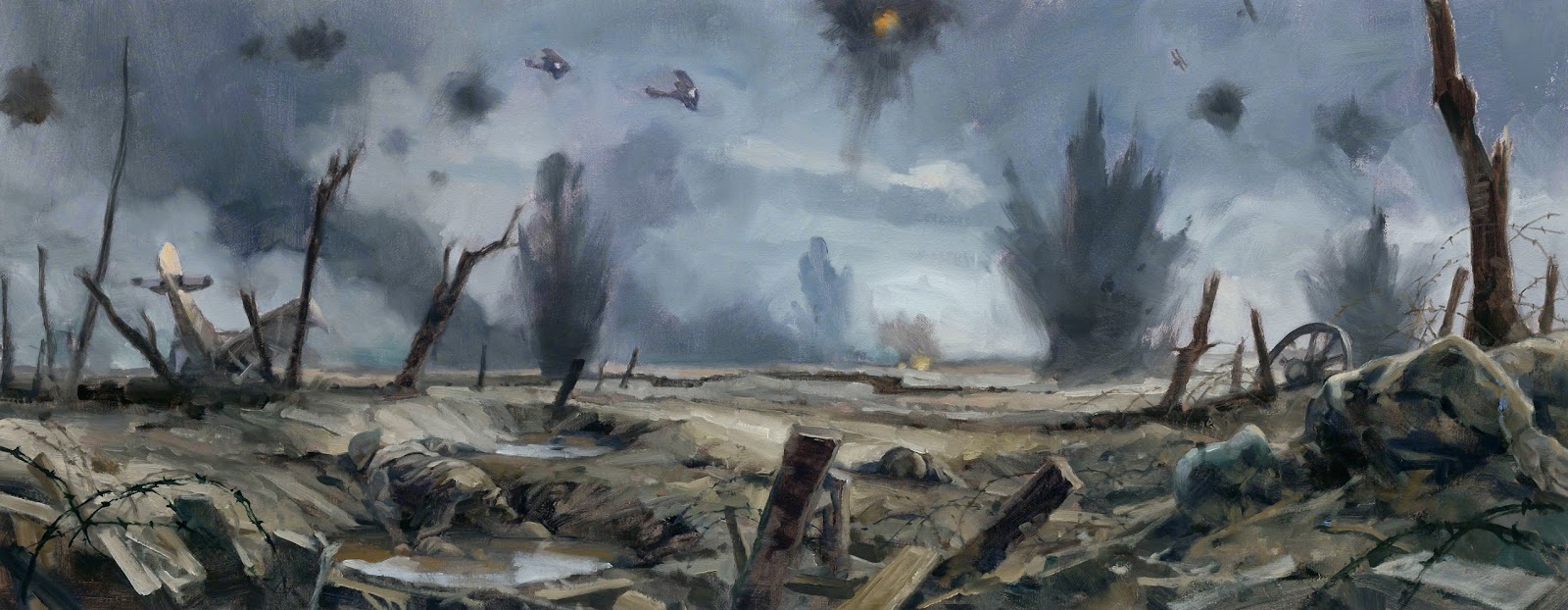
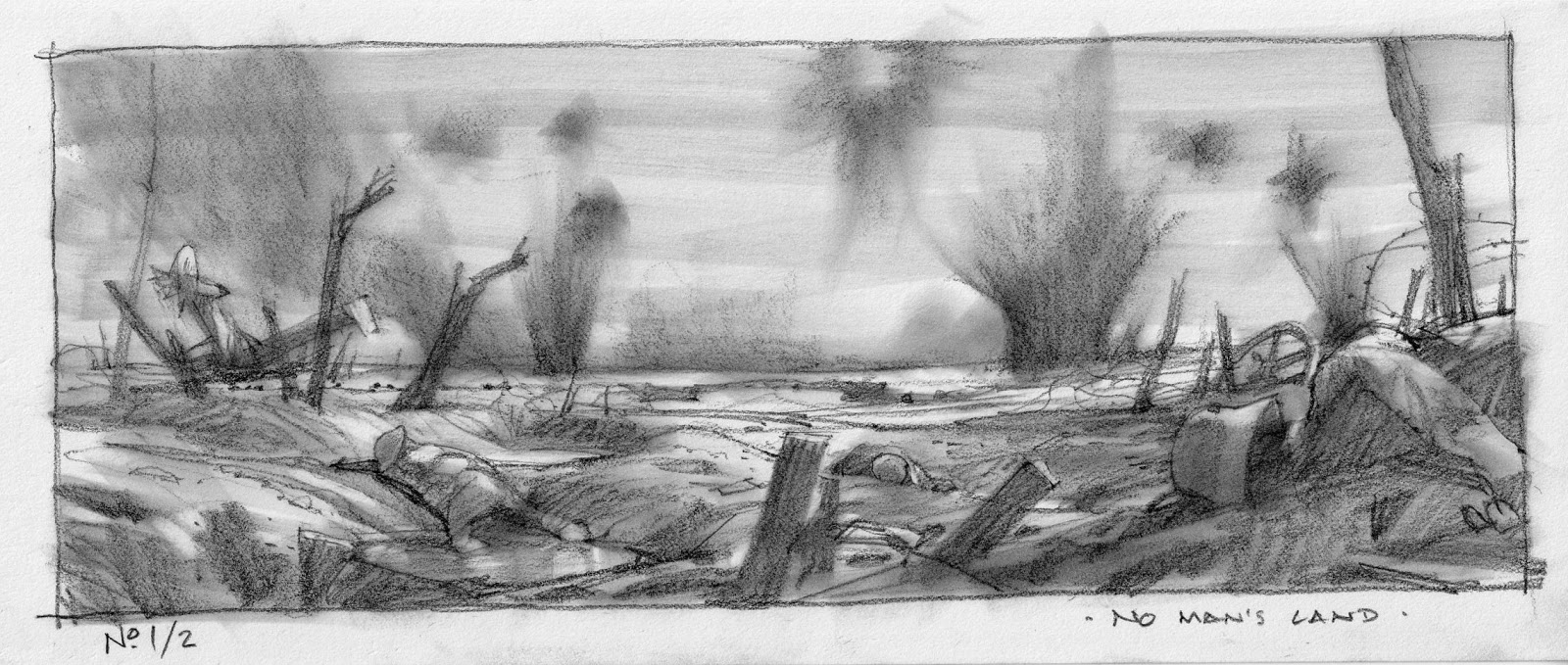
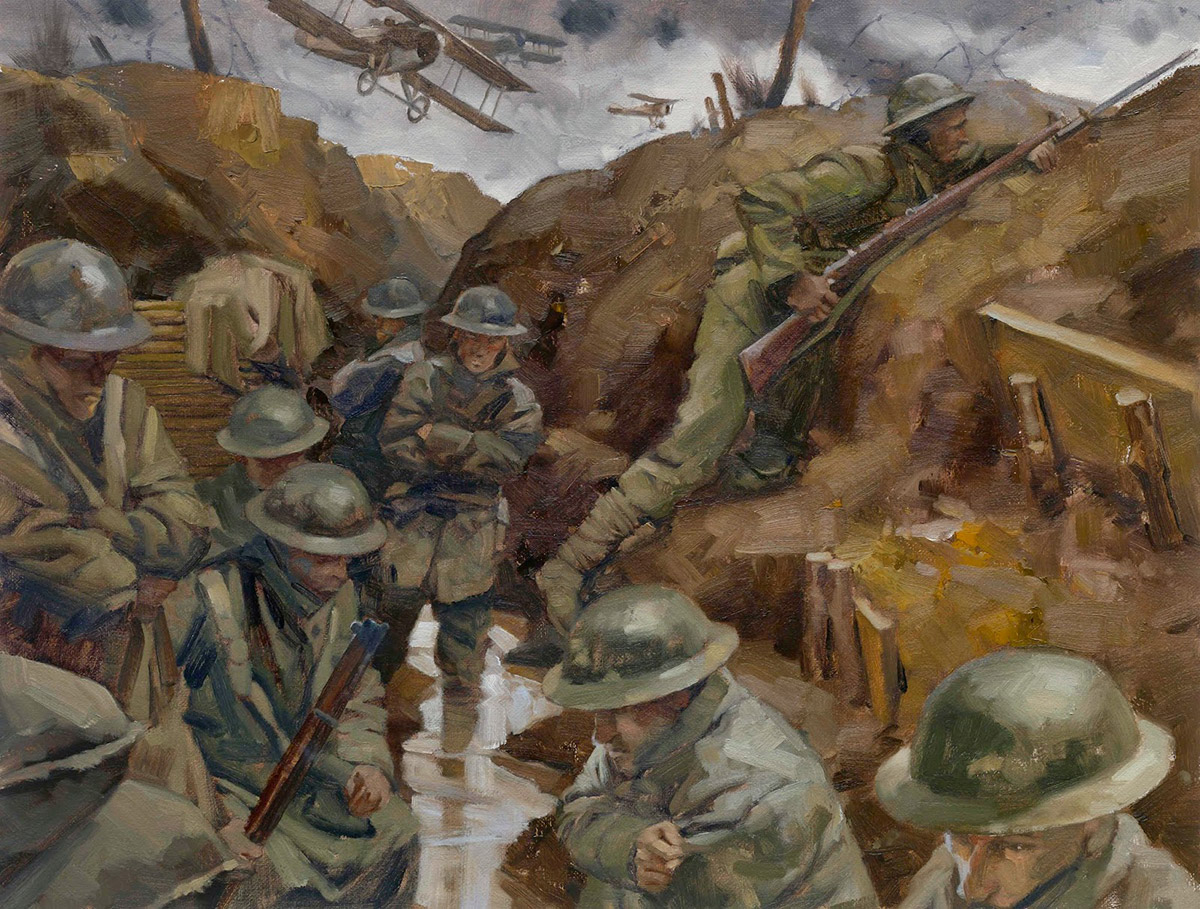
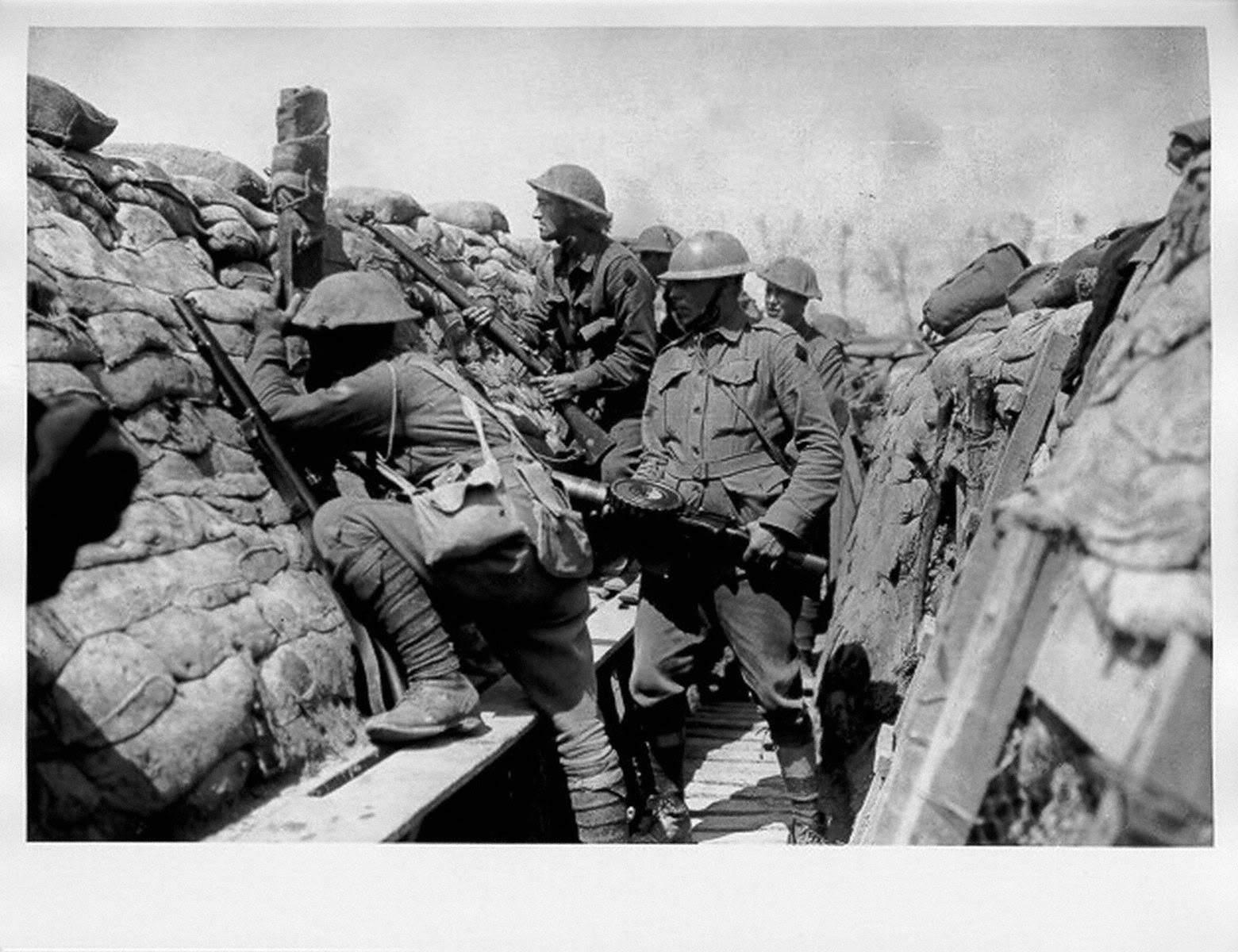
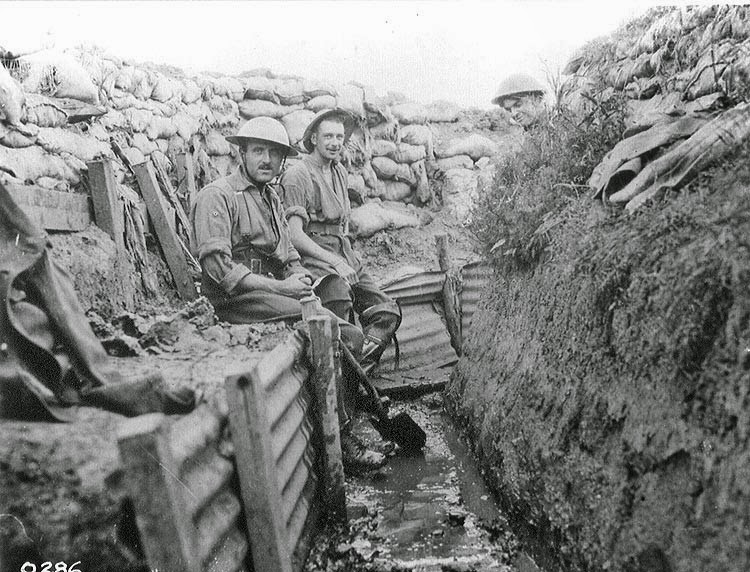
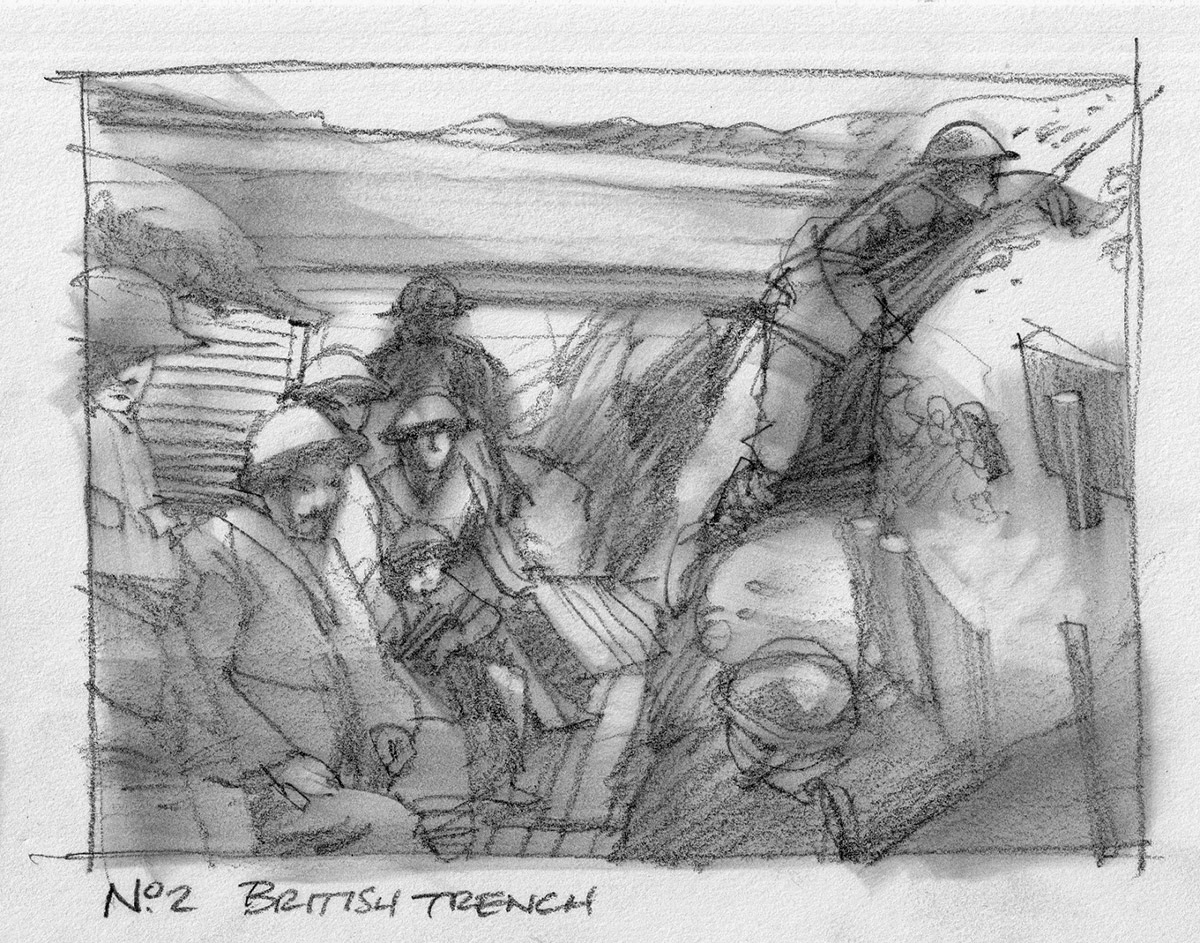

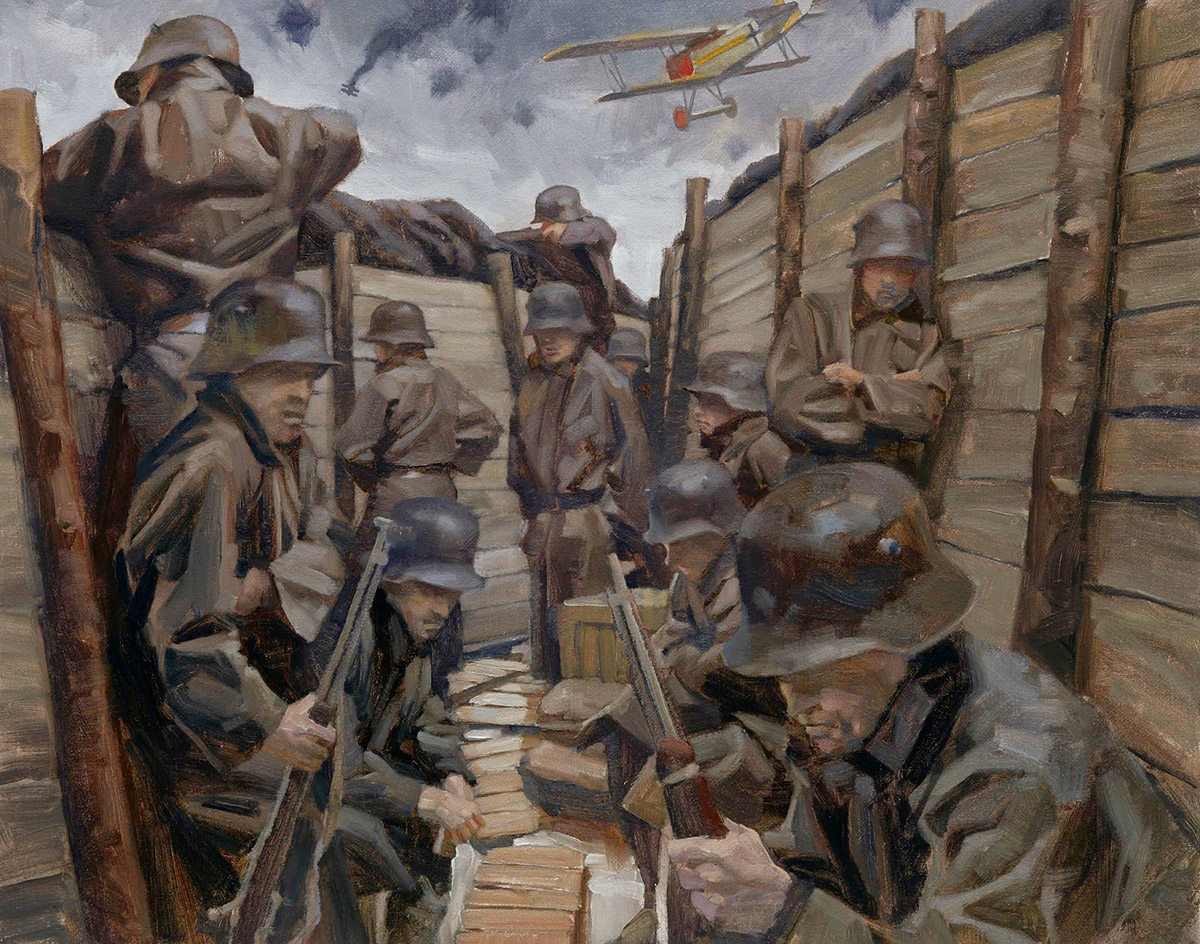
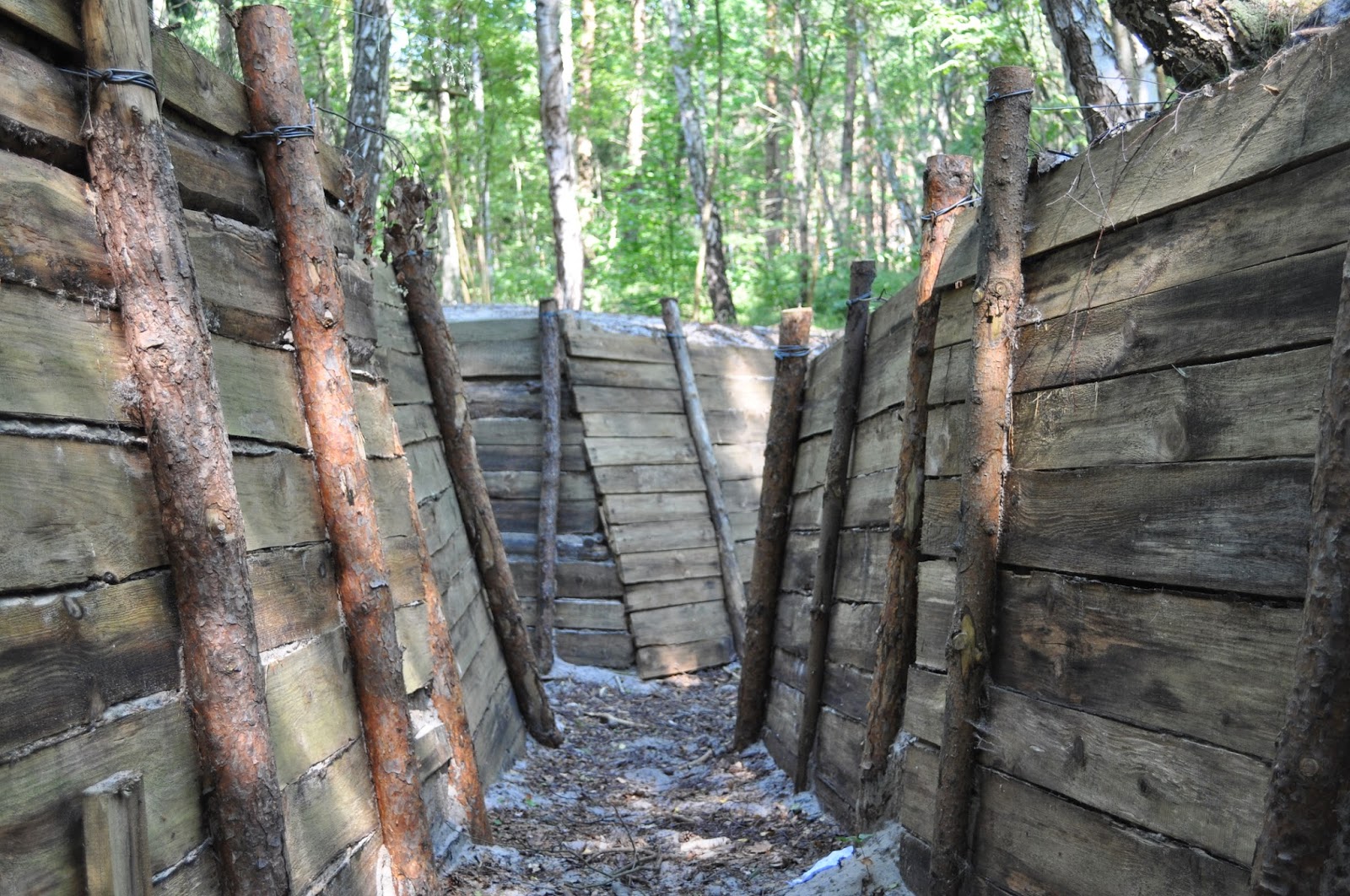
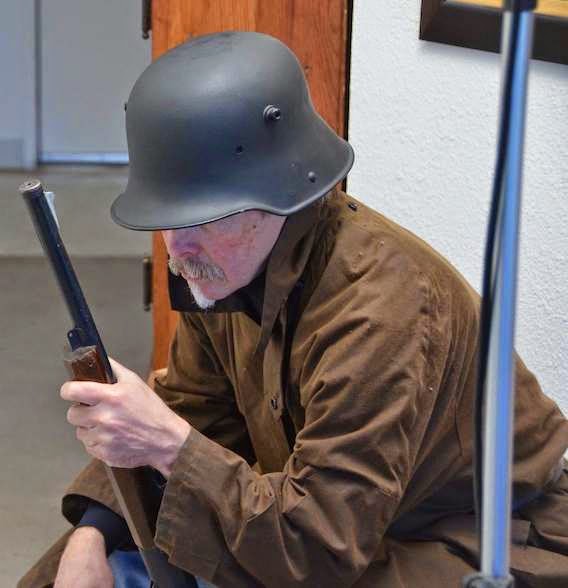
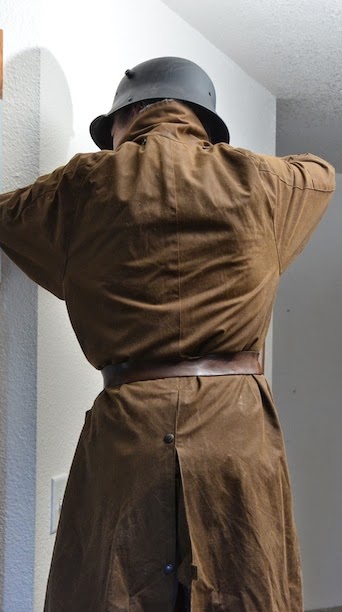
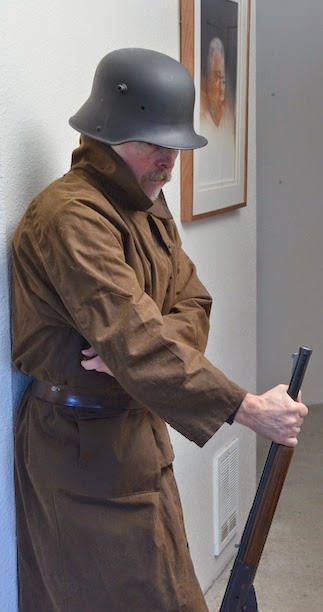
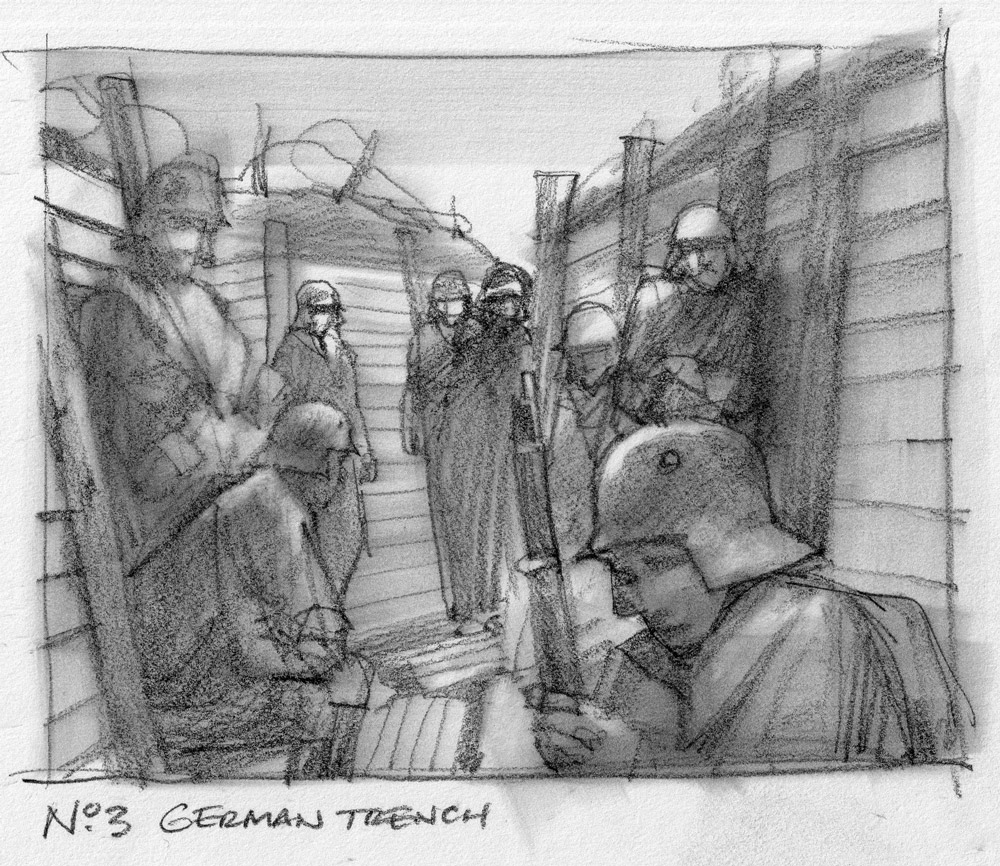
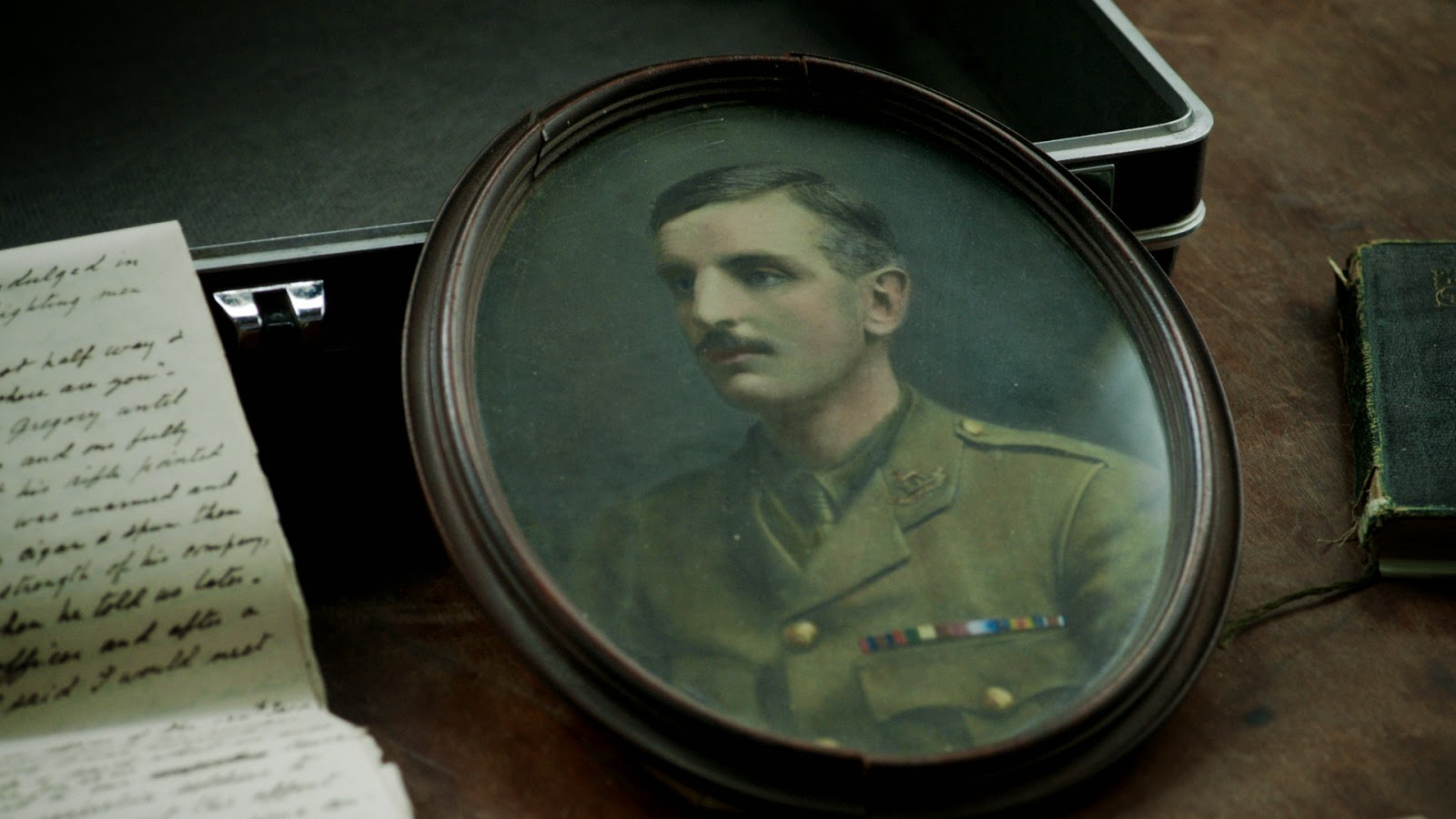
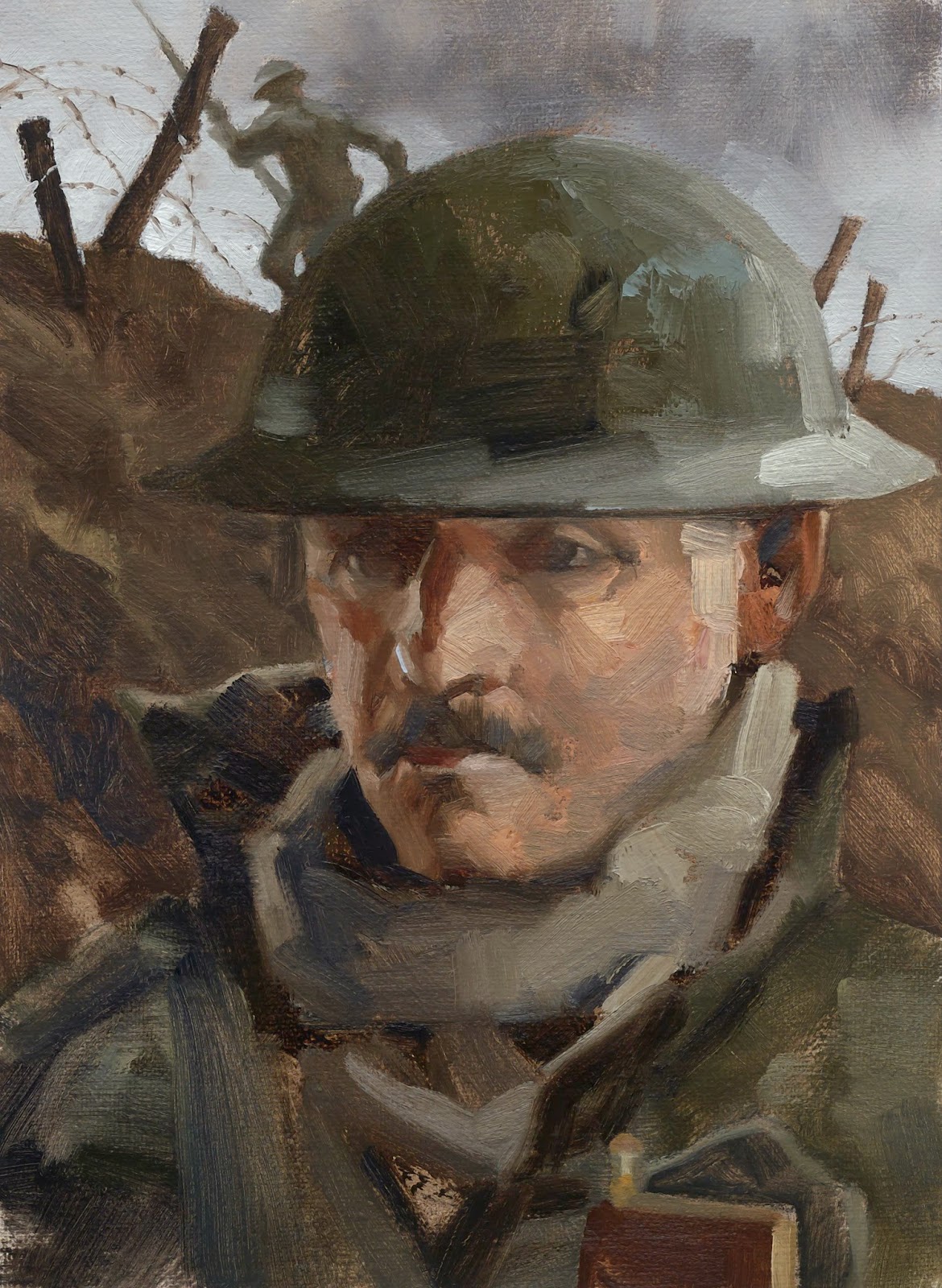
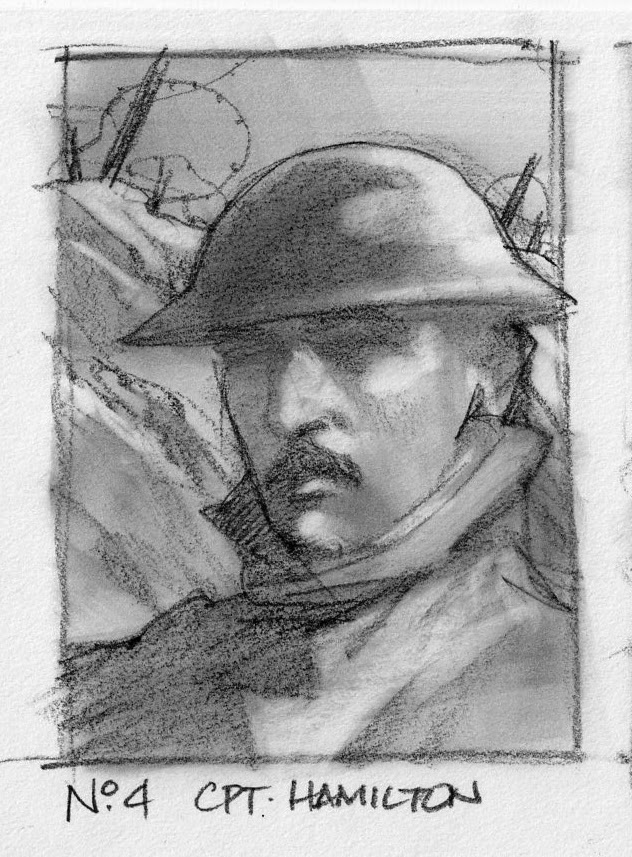
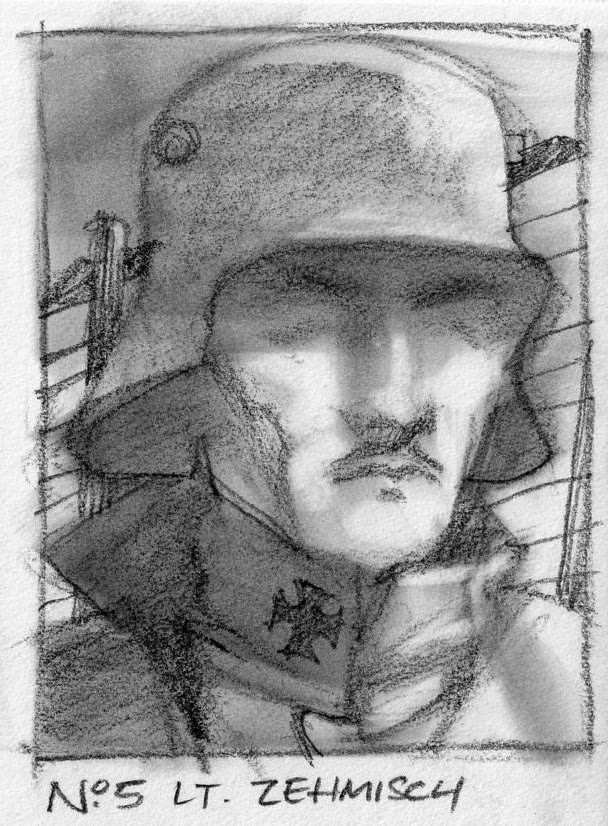
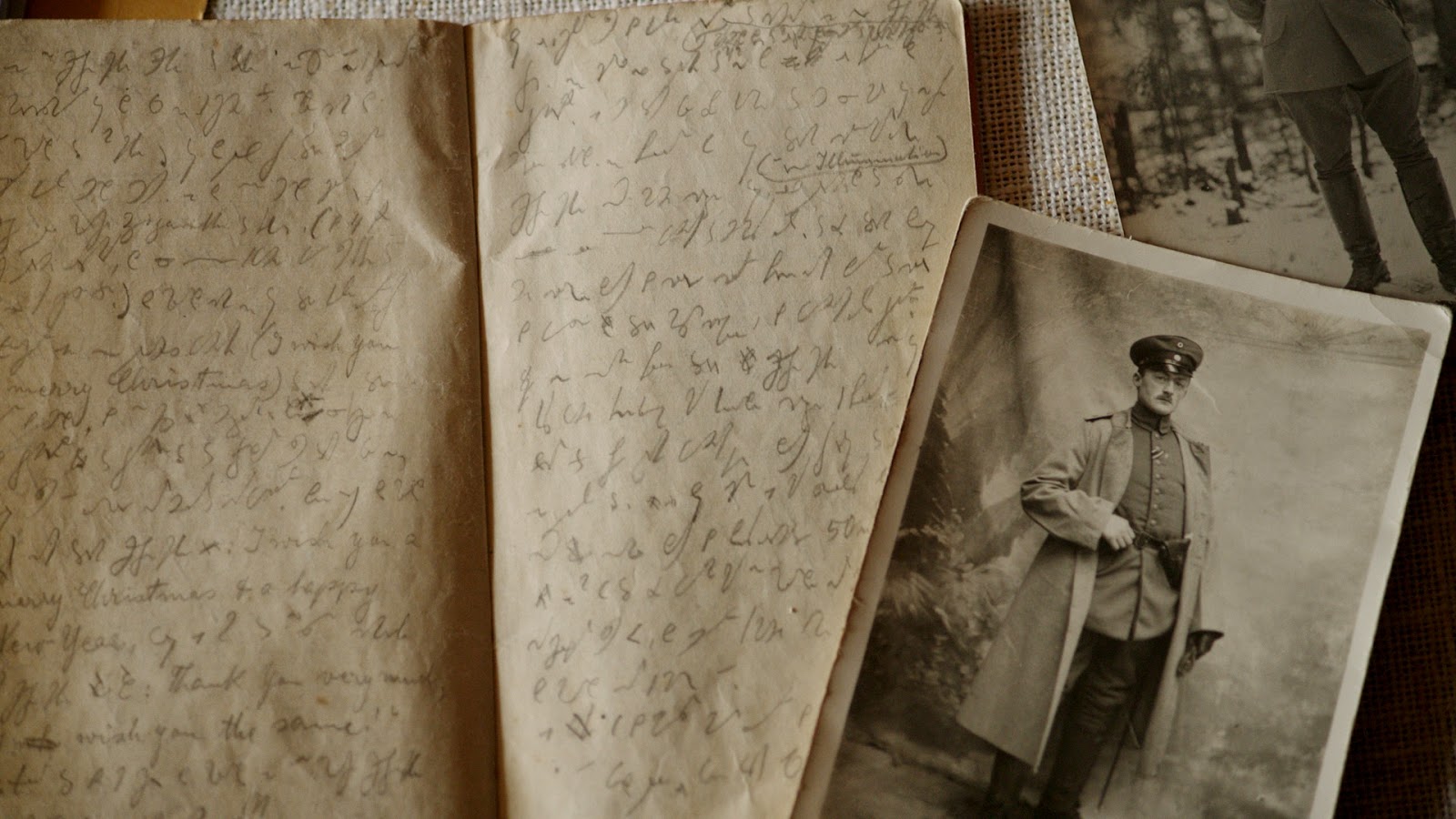
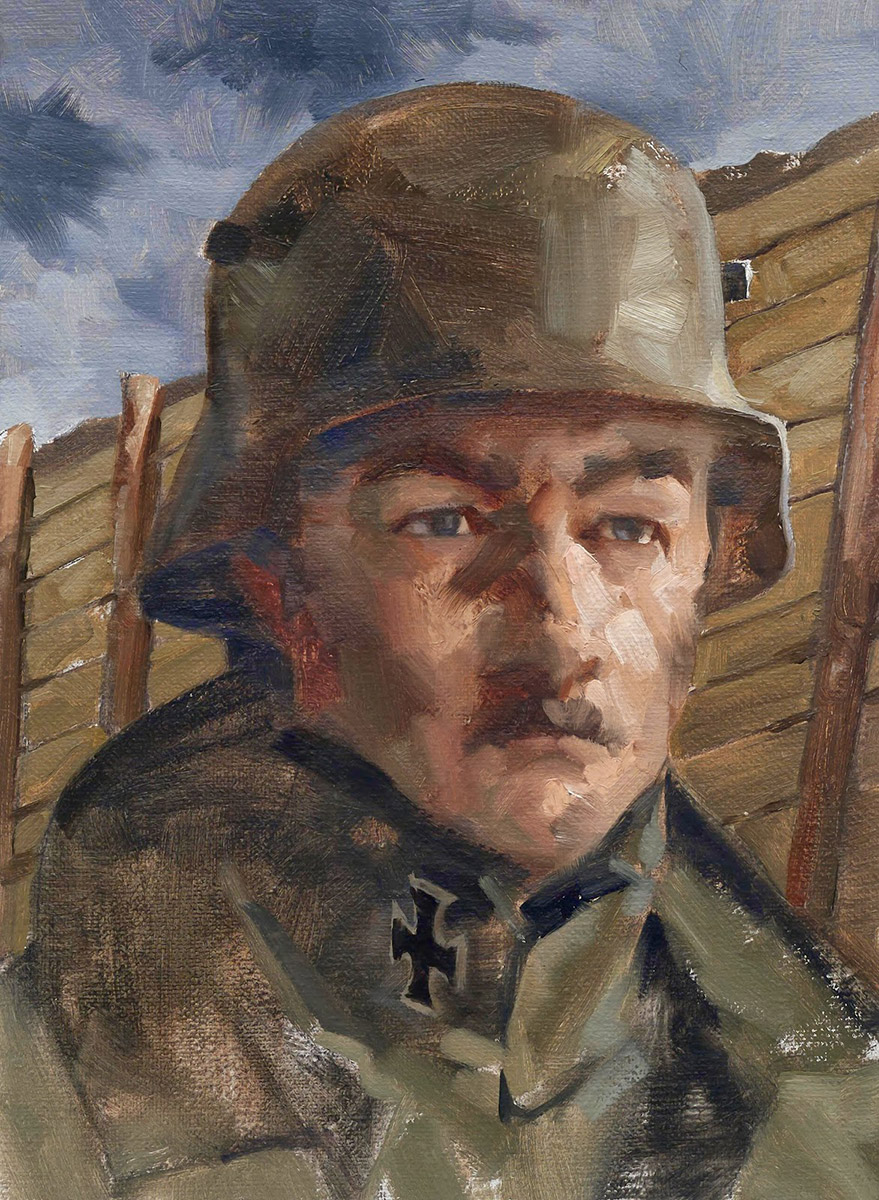

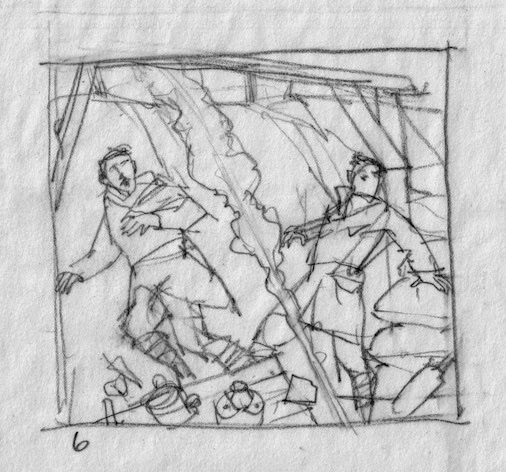
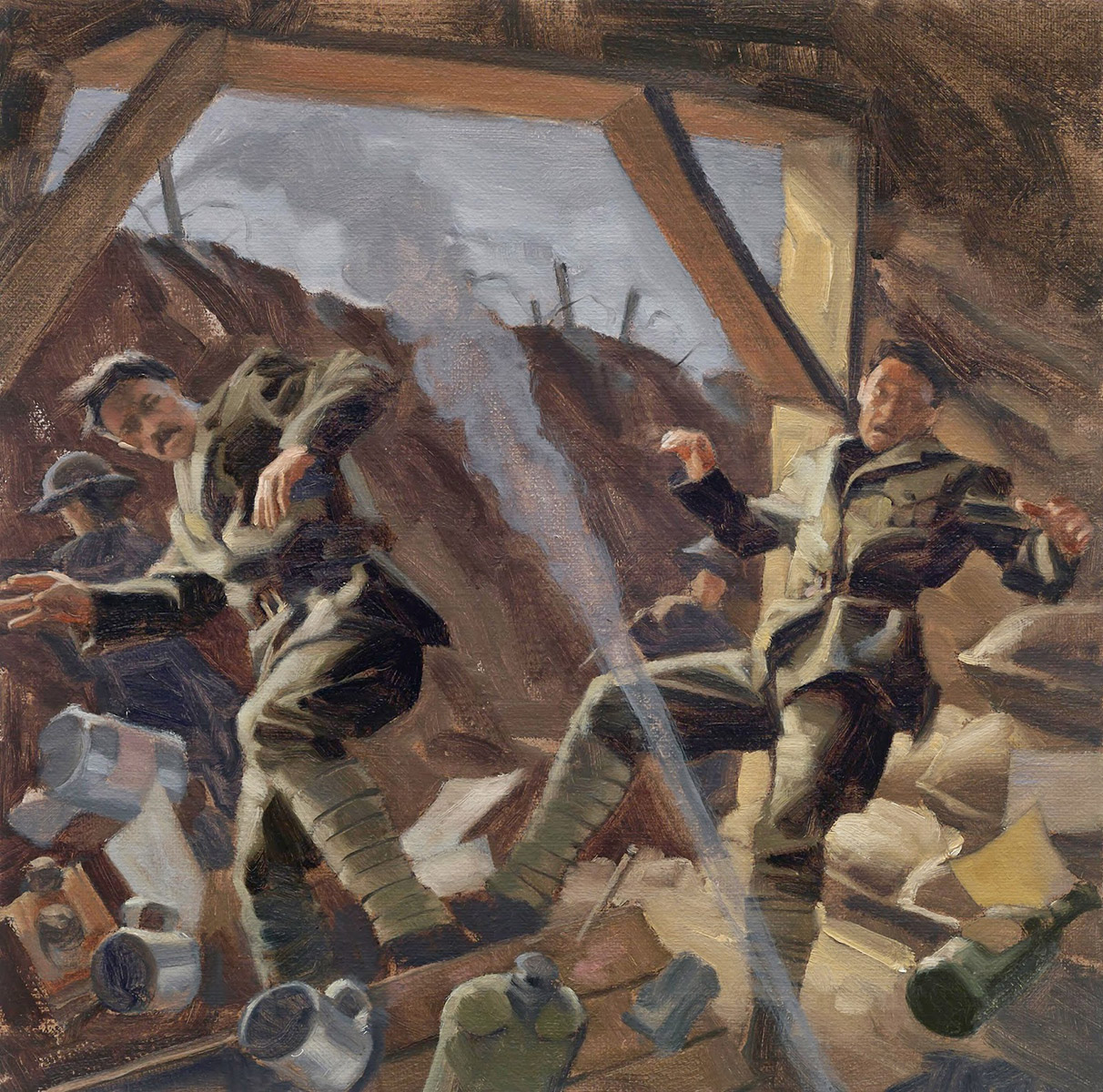
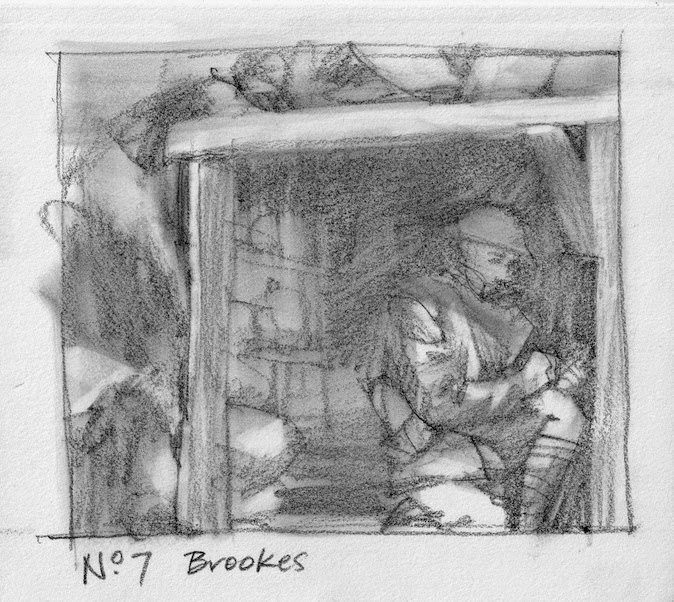
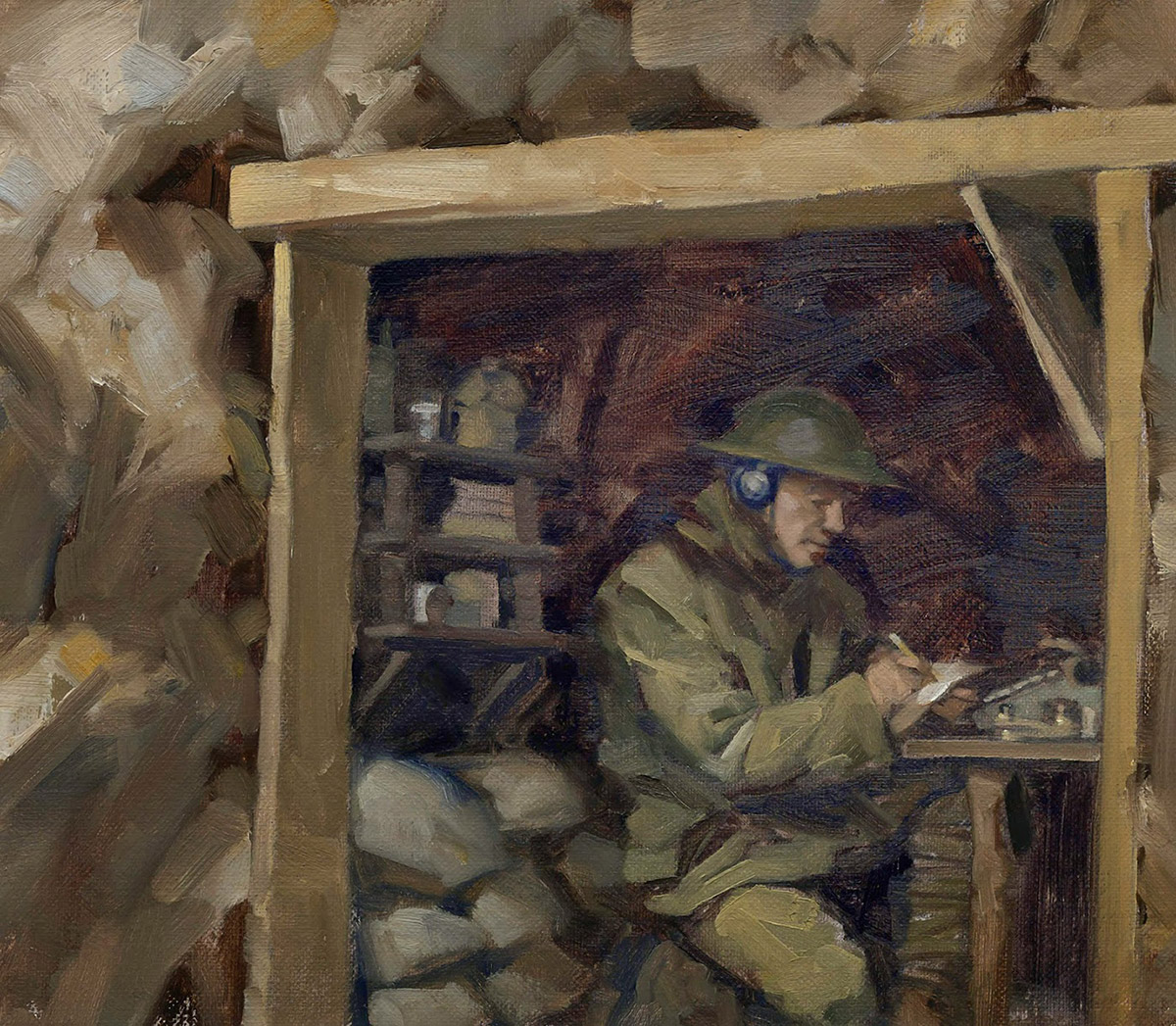

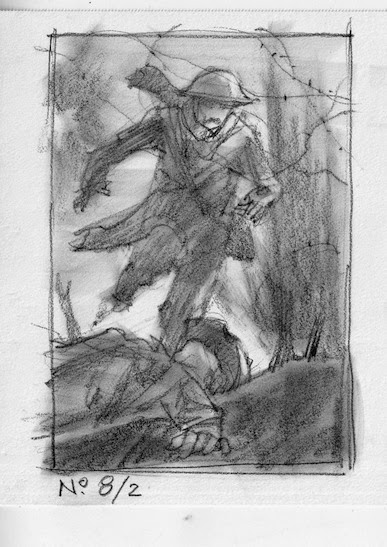
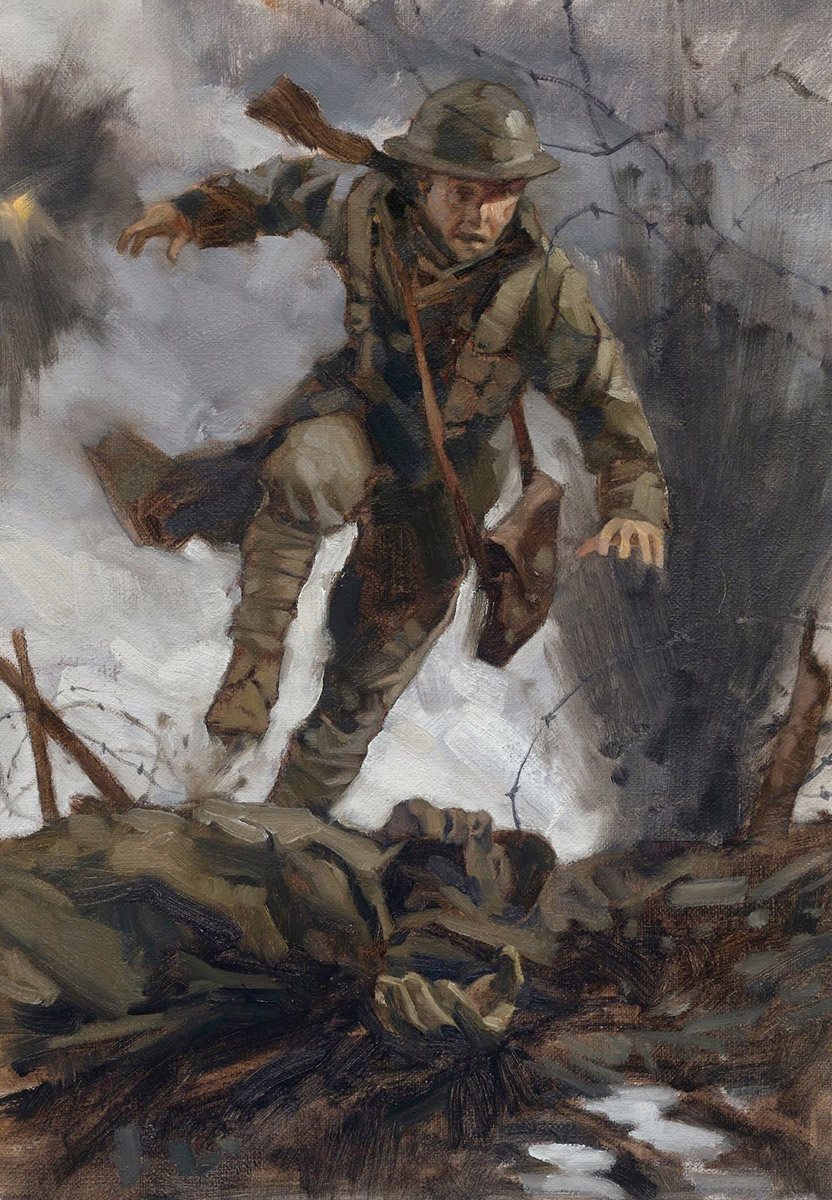
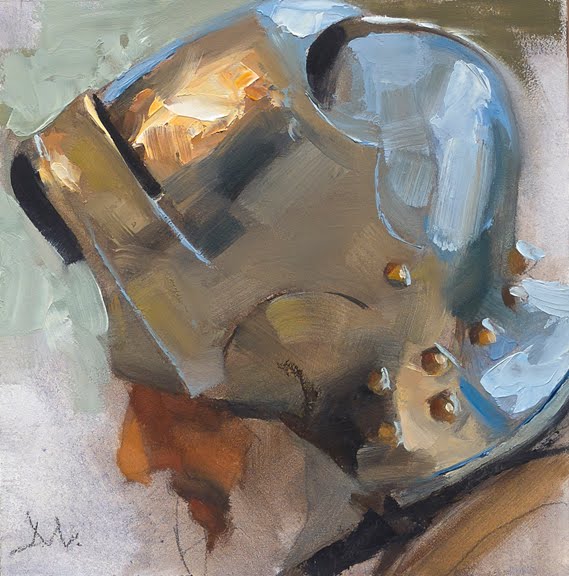
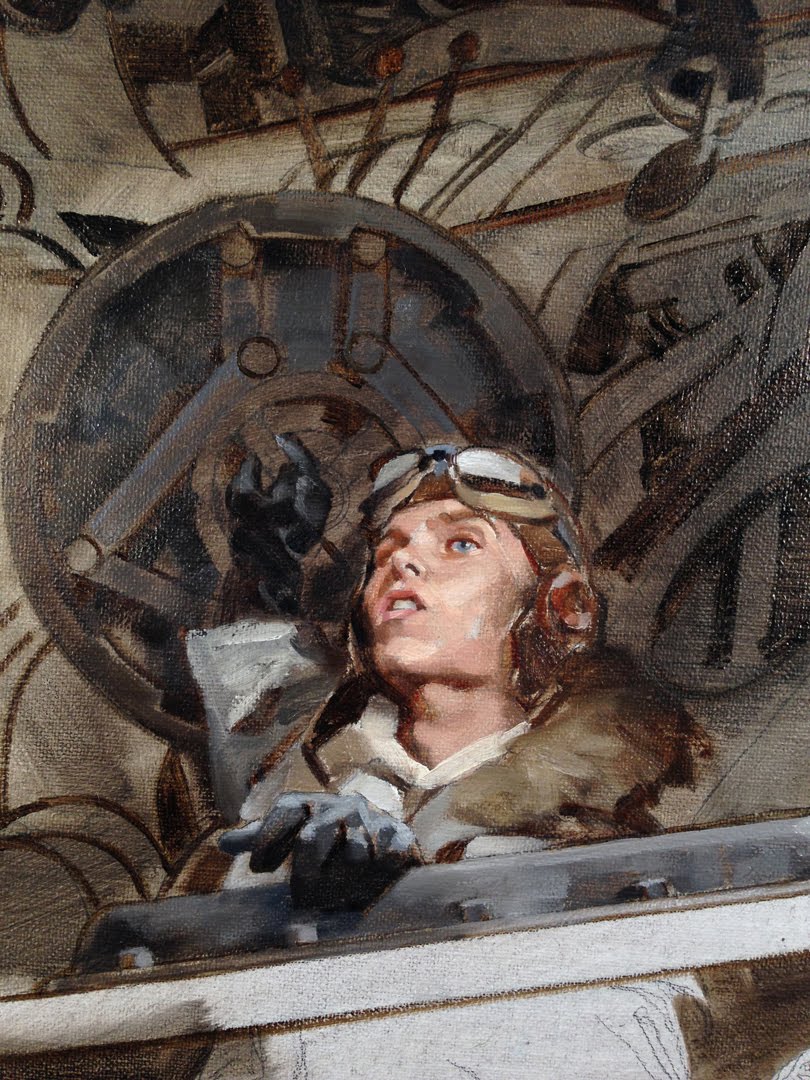

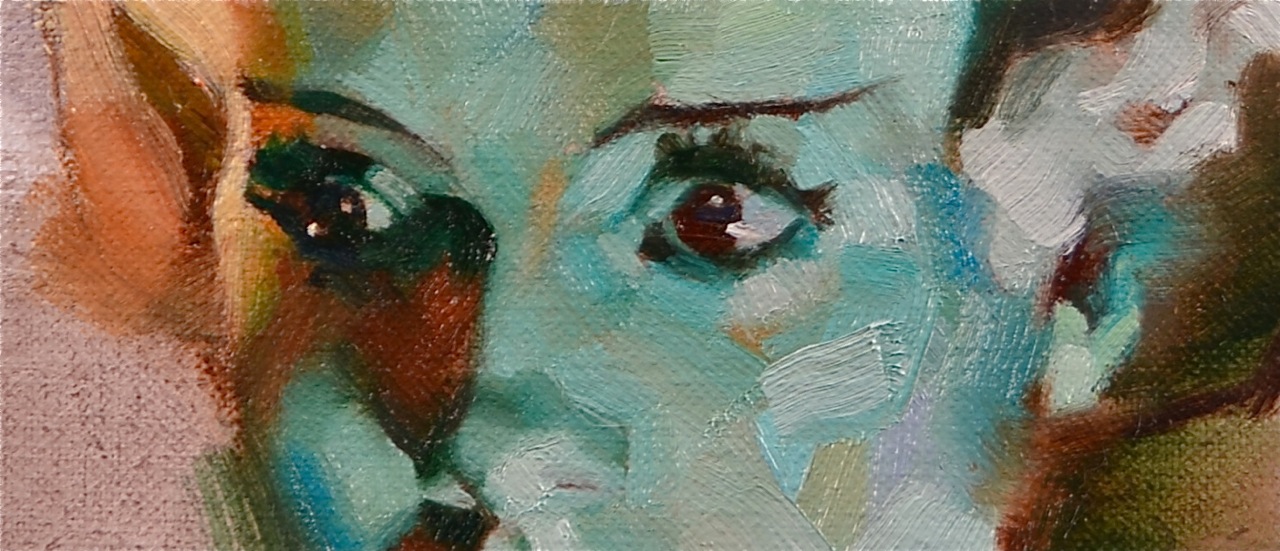

Wow, that's a lot of work in limited time. I can only focus for about an hour or two. Then it's lots and lots of little breaks…
Cliffhanger! I love this story, greg, can't wait till part two
I enjoyed hearing you talk about this project while monitoring your smartschool class. It's great to see the work and hear more about the harrowing production of the pieces. Epic stuff!
Great story, thank you for sharing this tale.
I remember reading about the Christmas Truce as a young history student and being very moved. these paintings are wonderful.
Wow, this is pretty intense. You're just the guy to do it though. The paintings look fantastic! Can't wait for part two.
Woah. Heart's racing. I'd love to hear what other illustrators think?
Would they have taken the gig, do you think?
Or are you just as courageous as the people you're painting? Ha. I've never been more inspired to hit the brushes! Thanks Greg!
I'm thoroughly engrossed here. Also inspired to do a LOT more drawing.
Oi. Thanks for the vicarious artist ulcer! Sounds like you were handling this with a level head though. Bravo.
Holy smokes, I'm on the edge of my seat! Great post…(and awesome artwork)
Way to leave us in suspense, Greg!
Hah! Thanks, all!
It gets worse. : )
I can't recommend working like this. And you should also know that I've put in a lot of years of testing my skills. Early on I found them wanting. So I focused a LOT, and over time have been able to keep up with client demands.
In fact, I'd suggest: never let the client know how fast you work, if possible. This can work to your advantage when the 'chips are down' or they're desperate, as they were here. Let's you look like a hero.
Clients appreciate your honesty, too. If you can't handle a job, let them know that. On this one, tho….I was riding that razor's edge….
Definitely looking forward to the conclusion!
Great blow by blow, Greg. WOW! How much coffee is involved?
Talk about Life in the Trenches! – sheesh…
Jeez! You're making me tired! i'm lucky to finish a five by eight watercolor in four hours.
Not much caffeine, Chuck….I can't have any. So I'm on decaf mochas, but a lot of hot chocolates! I suppose it doesn't make for a gritty tale, like plugging down scotch and chain smoking as I go, or popping amphetamines.
To get it done, I had to have sleep, real food, no interruptions, good music, committed attitude.
Boooooring! : )
I think I'm going to hyperventilate from the stress. The situation couldn't have been healthy for you and waiting to find out what happened isn't healthy for me! 🙂
Great art here.
You need to put out a book of your art. Maybe include some stories like this one, all of it, the good and the bad,the story behind the commission instead of the usual technique/instructional stuff.
We need a new spin on the art book. Human interest stuff much like the history subjects you illustrate.
But written by you in your words, not someone else's. Perfect fit.
Waaay overdue.
I second David's post above. The Art of Greg Manchess book with stories like the one in this post would be awesome. Take my money! (even though I'm broke.)
So, if what I'm reading is right, you fought the war all by yourself, by cloning yourself?
Totally agree about never letting the client know how fast you work. Learned that working in textbook publishing. If I got my work done early, they just piled on more work till I had too much work.
So I would finish early, sit on it, then turn it in slightly early, and be the star of the show with not that much effort. And those few times where I was late, was ok, because everyone thought I was always working hard.
And if you take on a tight deadline knowing you can work fast, don't say that. Say, man, this is going to be really hard to get done in this time frame. I'm going to have to rearrange some things. Make sure they know you are doing them a favor and and that it's an exception.
Fantastic post, and I especially love how you detail how much you worked with the client to make a completely impossible thing possible (or at least slightly less impossible) by offering creative suggestions and workarounds. Clients <3 that.
Thank you for allowing us to benefit from your experience. This first article will definitely be a valuable reference for creative problem solving techniques. I am excited to see what happened next. I hope it's appropriate to ask what size your thumbnails were originally? Thank you again for your professional insights.
Wow sounds like a nightmare job, but a great story came from it! And hopefully a nice fat paycheck. Can't wait for part 2. Also Greg could you post the sketch that sold them on you, the print out with oil paint on it? Would be great to see what put you over the top. Thanks!
God – I hope they paid you well for all that hassle.
I really hate to be a spoilsport because I'm a big Manchess fan. But the British and German armies did not in December of 1914 have the helmets depicted; by 1916 or thereabouts, they did. Also, the aircraft in one background is also of later vintage.
On the other hand, most viewers would not recognize these anachronisms, and simply think: “Yup, that World Was I all right.”
Dang! I forgot to include that, Matt! Thanks. I'd meant to, but the post ran long, so I forgot about it. I will in part 2, or maybe at the end? I don't know.
I will definitely do that art book with stories, you all. Thanks for pushing that. I, too, think that the real stories behind the assignments are much more interesting. Will do.
Thanks, Lauren! I was very much at the top of my game to get this done for them. I had to be. And you're right: part of the creative effort extends beyond just the images, and in how they are accomplished and how one can figure out ways to blend with the client to meet the deadline and the parameters requested.
And part two of the post for this job was no picnic……
Hah! You noticed, Donald! That's part of the next post.
But you're right in that I just missed on the German helmet, not the British. The Germans had those spike helmets, with coverings in '14. (The British also realized that the spike was great for targeting soldiers in the trenches, so they were later removed.) But I looked it up a little later and found that the helmet I used came into play in early 1915, just after Christmas, not 1916.
Good catch!
Donald….which aircraft….German or British?
I love this! Thanks Tim Paul.
And great post too, Greg. I can't wait to read part 2!
Ryan….totally appropriate. The thumbnails are fairly small….about 3 to 4″ across. No Man's Land was wider, of course, at about 6 or 7″.
Gregory, actually all the aircraft in the images towards the top look more 1917 than 1914 (I'm approximating, just as I did with the helmet dates — lazy me!). The 1914 jobs essentially were spindly things, often with rotary (rotating) motors.
The largest plane in the British trench looks similar to the French SPAD VII from 1916, whereas the German trench scene's plane seems to be a Fokker D.VII from early 1918. Its cross marking is late-war; most of the war Germans used the classical Iron Cross motif on their aircraft.
The British helmet was first used in 1916 — see Wikipedia entry for Brodie_helmet.
Thanks, Donald! Weird though….I have shots of Brits from 1914 wearing that helmet. I dunno….maybe the shot was dated incorrectly. And Wiki is not always dead-on.
Got me on the planes…..I was moving so fast, I neglected to check the date of the different models. You're right about the cross shape (that would've been cool!) and spindly is right!
I wanted to get as much correct as possible, but again, so little time. Frustrating, now that I have the time to correct it! But I go with the spirit of the thing more than the specifics. (or…that's how I'm gonna live with it anyway! ; )
Job-Shack–A contractor network site for 1,000 of the largest general contractors looking for sub-contractors in your area .
Contractor
The “1914” helmet pix must have been miss-dated. British troops in the early going only had cloth hats. Ditto the French. Only the Germans had helmets — those close-fitting, spiked “pickelhaube” (I'm guessing at the spelling) kind that wore cloth/canvas covers in combat zones. Then they shifted to the better-protective kind we are all familiar with.
Nerdy detail: the German WW1 helmets were slightly larger than the WW2 kind. Many/all/most had studs on each side. These were fittings whereby a curved armor plate could be attached; it offered more protection for the forehead.
One of my favourite moments in history by one of my favourite artists. Doesn't get much better than that. The paintings are brilliant, they really do convey the dirt and grime, and the expressions on the soldiers really give such a great sense of mood. Love how you convinced them that you're the guy for the job. I saw you hinted at a book to be made eventually. Don't care how much it costs, I want!!
Thanks, Matt! Update will come soon….things are looking good!!
And I was told those studs were for gas mask attachments, although it didn't make much sense as to how that worked.
Thanks for the nerdy details, though, Donald! Love that stuff….
I could see this in my mind as a documentary. Such tension! haha
Thank you so much for sharing all that with us. It's really fascinating to get a glimpse at what it can be like to be a professional artist.
I look forward to part 2!
Oh and, like Matt above, I'm very curious to see the painted sketch that got you the job.
Cheers!
This is a great – tense – walk through of the obstacles involved with taking gigs! Incredibly informative and serendipitously suspenseful, like 'edge-of-your-seat' entertainment for freelancers, haha.
I'm also eager to see the initial sketch and color comp that won you the gig. Hopefully next post!
Cheers, Greg,
Thanks for your time with this,
Mairin-Taj
Gregory…Is any of your work available for book covers? Just finished by fourth novel and this one begins in the First World War and your painting of Signalman Brookes would be perfect. Please define costs etc.
ass cheeks